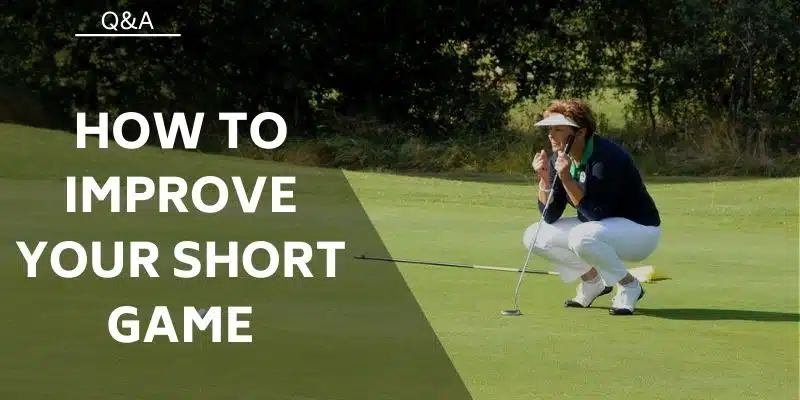Made famous by Canadian Golf Professional Moe Norman, the single-plane or one-plane golf swing is a unique way of swinging a club.
But what exactly is the single-plane golf swing? As the name suggests, the single-plane golf swing returns and comes down on the same swing plane. It can be easier for beginners to master since there are fewer details to focus on, and you can hit more consistent shots. It could also increase your distance and reduce your risk of injury. But it also leads to more hooked shots, you can’t fade your shots, and it limits your speed and power.
In this article, you will learn about:
- What the single-plane swing is
- Potential benefits of the single-plane swing
- Potential disadvantages of the single-plane swing
- How to execute the most common variation of the single-plane swing
- Common single-plane swing mistakes
- What pros use the single-plane golf swing
- And more
Let’s dive in!
What Is The Single Plane Golf Swing?
A single-plane golf swing is a type of golf swing that involves keeping the club and the hands on a single plane throughout the swing. In other words, the club shaft is kept on the same angle throughout the swing, which is usually a flatter plane than a traditional swing.
This type of swing came from Moe Norman and was popularized by golf instructor Jim Hardy and is often used by golfers who struggle with consistency in their swing.
Todd Graves’s book, “The Single Plane Golf Swing- Play Golf the Moe Norman Way,” is the go-to guide for learning the original one-plane swing.
The idea behind the single-plane swing is to simplify the swing mechanics and reduce the number of moving parts, making it easier to repeat the swing and hit more consistent shots.
However, it’s worth noting that not all golfers may benefit from a single plane swing. It’s important to work with a qualified golf instructor to determine the best swing technique for your individual needs and abilities.
Read More: How to Swing a Golf Club (Simple Step-by-Step Guide)
Single Plane Golf Swing vs. Two Plane Golf Swing
A two-plane golf swing is thought of as a conventional swing. Below are some of the most notable differences between a more conventional swing and a one-plane, Moe Norman-inspired swing.
| One-Plane Golf Swing | Two-Plane Swing | |
| Set Up |
|
|
| Backswing |
|
|
| Downswing |
|
|
| Impact |
|
|
| Release and Finish |
|
|
Check this out: 10 Best Golf Training Aids For Your Swing Plane
Benefits of the Single-Plane Golf Swing
There are many noteworthy benefits to the single-plane golf swing. These items are why this may be a more appealing approach for new golfers, seniors, or those with back or other health issues.
Improved Consistency and Accuracy,
The pure simplicity of the one-plane approach can improve consistency and accuracy for those who struggle with it. One of the significant challenges to the more conventional, two-plane swing is that there are many moving parts.
Golf gets easier when you can eliminate the number of things that need to take place to hit consistent and accurate shots. Of course, you will be giving some things up with the one-plane swing, as we will see soon, but the simplicity of this method is appealing.
Increased Distance
The one-plane swing has the potential to help increase distance because you will be able to swing from the inside to out much easier. The in-to-out swing path helps create a natural draw. When you draw the ball, you can get more out of your shots from a distance perspective.
However, this has a potential downside, which we will see shortly. Many golfers struggle with hitting slices and only making a glancing blow of the ball at impact. With the one or single-plane approach allowing golfers to hit more solid shots easier, those slices could be a thing of the past.
Reduce Risk of Injury
One of the most notable differences between the single plane and the conventional swing, in terms of impact on the body, is how much less abuse your back will take. The single-plane swing reduces the rotational forces needed from the hips and upper body. It also limits the crunching of the lower back over many years.
Golfers that stay in good shape and have a strong core and lower back should not see issues using a more conventional swing. Unfortunately, the reality is that many golfers do not stretch properly and are not fit enough to handle the stress the body goes through over many years of playing golf.
Even though some trade-offs exist, the one-plane swing may be a good alternative for many golfers.
Easier to Learn and Execute For Beginners
The significant advantage of the single-plane swing is that it’s simple to learn for beginners. In addition, this method takes away much of the frustration of learning the more traditional swing. Again, there are trade-offs, but most golfers do not want to compete at a high level. Most want to have fun and play a decent game.
Read more: The Best Golf Tips to Improve Your Game
Disadvantages of the Single-Plane Golf Swing
As good as the single-plane method may sound, there are some disadvantages. There are clear reasons why many golfers stick to the more traditional, two-plane swing method.
Let’s look at those next.
Limit of Speed and Power
While it’s true that the one-plane swing raises the chances of hitting the ball more solidly, it does pose a problem with creating speed and power.
The power potential will inevitably diminish when we limit the most significant power source of the modern, conventional swing, which is rotational forces from the body.
It’s genuinely a give-and-take. Where the one-plane swing can offer consistency in ball striking, it will limit speed generation and power potential.
Harder to Fade The Ball
The one-plane swing allows golfers to swing easily from the inside out. This swing path makes hitting draws possible, appealing to many golfers. However, the takeaway is a golfer’s potential ability to hit fades.
A complete golfer can hit both draws and fades. That gets complicated for one-plane swingers.
Can Lead To Hooked Shots
Additionally, while allowing golfers to be better suited to hit draws, the one-plane swing also introduces the potential for being prone to hitting hooks.
With an in-to-out path and a strong trail hand grip, the possibility of getting the hooks is real.
How To Execute a Single Plane Golf Swing
The following is a simplified step-by-step guide to executing a single plane swing.
Step #1- Get Set Up and Aligned Properly For a Single Plane Swing
- As you get set, you will want to get your arms more extended and away from the body than you would in a conventional swing.
- Your hands are set higher than in a two-plane swing.
- The club shaft is set in line with your trail arm.
- Because of that setup adjustment, your body will be slightly further away from the ball than in a conventional swing.
- You will want to get into a much wider stance that is more than shoulder width.
The big key in setup is a prominent secondary spine angle. This is where the lead hip bumps toward the fairway, and the spine tilts away from the target.
Step #2- Get Your Hands On The Club Correctly For a Single Plane Swing
- The lead hand is in a neutral position.
- The back of the hand is parallel to the clubface.
- The trail hand is placed in a strong position, with the V created by the thumb and index finger going past the trail shoulder.
In his book, Todd Graves refers to this as a “non-rotational position–similar to skipping a rock.”
Step #3- The Single Plane Swing Backswing
The backswing is where things get simplified. Most of the significant changes happen in the setup. You are setting conditions to produce a more streamlined, one-plane swing.
In the backswing, you naturally move the arms and club back to the inside onto the single plane.
No longer is there an emphasis on getting loaded into the trail side and rotating the hips and shoulders? There will be rotation, but it’s a natural move back.
Step #4- Transition and Downswing in The Single Plane Swing
On the way down in the single plane swing, you are simply returning to the club down on the plane you were set to at set up.
- The lower body moves into a flexed lead knee. This is a big reliever of stress on the lower back.
- In addition, this method does not require rotational forces from the hips.
You also do not need to worry as much about shifting pressure into your lead foot. In fact, you will feel your feet staying flat on the ground as you move down and through impact.
Step #5- Impact in The Single Plane Swing
- At impact, the lead knee remains flexed.
- As a result, the trail foot stays on the ground through impact, a significant difference from the conventional swing.
Again, we are simply returning the club to where it was set up. There are a few moving parts to this approach.
Step #6- Release and Finish in The Single Plane Swing
As you work through post-impact, the lower body stays stable with the trail foot on the ground. You will continue to swing through on that same single plane that you were at during set up, the backswing, on through the downswing, and at impact.
You will rotate the arms and shoulders to a one-plane finish. Your belt buckle will face toward the target, but your trail foot is still on the ground, and your lead knee remains flexed.
Read on: Open Stance Golf Swing – Our Tips To Golf Fundamentals
Single Plane Swing Common Mistakes to Avoid
The following are common mistakes to avoid while pursuing learning and executing the one-plane swing.
Doing Too Much in Your Execution
The single-plane swing is one of the most straightforward methods of swinging the golf club. For golfers who are new to the game and learn in the one-plane method, this common mistake is not as big of a problem.
For those of you who are traditional club swingers and are looking to try the one-plane method, be aware…you don’t need to do more than is necessary. This method is almost a set-it-and-forget-it scenario. It’s really all about getting set properly in the address position. From there, it’s simply swinging the club on that single plane you set up at address.
Poor Single Plane Swing SetUp Mechanics
You must nail those set-up conditions to be successful with the one-plane swing. Remember:
- Arms are more extended and away from the body.
- Hands set higher than in a two-plane swing.
- The club shaft is set in line with the trail arm.
- The body is slightly further away from the ball than a conventional swing.
- A prominent secondary spine angle. The lead hip towards the fairway, and spine tilted away from target.
- A wider stance.
- A neutral lead hand grip and a stronger trail hand grip.
Summary
The one-plane or single-plane swing is certainly a method to consider. It is a far cry from the more traditional, modern swing. But, like all things, it also has advantages and disadvantages.
What I laid out today was the original Moe Norman rendition of the one-plane swing.
There are a handful of tour professionals that swing in what is considered to be a one-plane swing. Most do so with elements of the Moe Norman method and the more traditional swing. They use more of a hybrid or combination of the two.
Some are closer to Moe, such as Bryson Dechambeau, and others, such as Steve Striker, are more of a hybrid.
FAQ
Does The Single Plane Swing Work?
The single-plane swing can indeed work. The most important aspect of making it work for you is following the setup and execution blueprint to a tee. You must also be aware of this method's limitations and decide if you will sacrifice those aspects. They include your ability to generate power.
Does Tiger Woods Use a Single Plane Swing?
Tiger Woods uses a two-plane golf swing, which is more difficult to learn than a single plane swing, but can be more powerful and accurate. Woods has tried to learn a single plane swing, but he has not been able to make it work for him. There is no one right way to swing a golf club, and the best way to find out which type of swing is right for you is to experiment and see what works best for you.
What Pros Use the Single Plane Swing?
Beyond the man who invented the concept, Moe Norman, there were, and still are, a few professionals that implement at least aspects of the single plane swing.
Bryson Dechambeau is the closest to the pure Moe Norman model. Others with single-plane aspects to their swing include Matt Kuchar and Steve Stricker. The great Ben Hogan was also considered a single-plane swinger of the club.
Where Did the Single Plane Swing Come From?
Moe Norman, a Canadian golfer, is credited with developing the one-plane swing in the 1940s and 50's. Moe was an awkward, shy kid on the autism spectrum, but he had an amazing swing.
His incredible swing later was recognized by many of the game's best, including Jack Nicklaus, Lee Trevino, and Tiger Woods.
Tiger Woods has said, "Moe Norman and Ben Hogan were the only two golfers in history to have owned their swings."
Brendon is Class A PGA Professional and founded Little Linksters, LLC, and its nonprofit arm, the Little Linksters Association for Junior Golf Development. He won 25+ prestigious industry honors, including the 2017 PGA National Youth Player Development Award. He graduated from the PGA of America Management Program and has a handicap index of 7.8.
He has played golf for over 40 years and currently plays twice a month at the Eagle Dunes Golf Club near Sorrento, Florida. He loves Srixon clubs and plays a ZX5 driver with Z 585 irons. He's written over 60 articles on GolfSpan and specializes in sharing tips to improve your golf game. You can connect with Brendon at LinkedIn, X, IG, FB, his website, or BrendonElliott@pga.com.
- Best score: 69
- Favorite driver: Srixon ZX5
- Favorite ball: Srixon Z Star
- Favorite food at the turn: Turkey and cheese on white








